Sometimes I wonder if I’m a “serious” artist. I mean, I don’t really worry about it, but it crosses my mind. Anyway, do I really want or need to be a “serious” artist?
And what is “serious” art anyway? I suppose it’s art with a purpose, with an important message, or with a revolutionary way of viewing the world. It tackles important social, political, or philosophical topics. It’s cerebral rather than emotional. It makes you think rather than feel.
Obviously, I don’t believe a word of it. Art can’t be and isn’t bound by such rigid and passionless beliefs. It’s possible and desirable for art to both provoke thought and evoke emotion.
Still, the one thing considered most “unserious” in art may be sentimentality, while its opposite, irony, is nearly worshipped.
By this one measure, then, I am certainly not a “serious” artist. Sentiment literally means feeling. I’m all about feeling, and that trait is reflected, I think, in my quilts, especially those of my family members.

Pippin
“Dixie Dingo Dreaming,” the quilt of my dog, Pippin, is a good example. I didn’t create this quilt in order to make statement. It is simply a portrait in which I hoped to capture the likeness and character of my beloved pet.
Pippin was a rescue dog from Georgia. When I described her to an employee at the local feed and farm store, she replied, “Oh, she’s a Dixie dingo, then.” I’d never heard of them, but a quick Google search and, sure enough, there she was, the native canine of the Americas. Later we came to suspect she had more than a little cattle dog in her, too, but the dingo description followed her for life.
Like many of my quilts, this one had an extended gestation period. I always seem to be setting fabric aside for future quilts. Once I had “dingo” in my mind for Pippin, I made the connection to Australia and to Aboriginal prints. I decided when I did make a quilt of her I would use all Aboriginal-design themed fabrics. For several years, everywhere I went, I was on the lookout for Australian-looking fabrics.
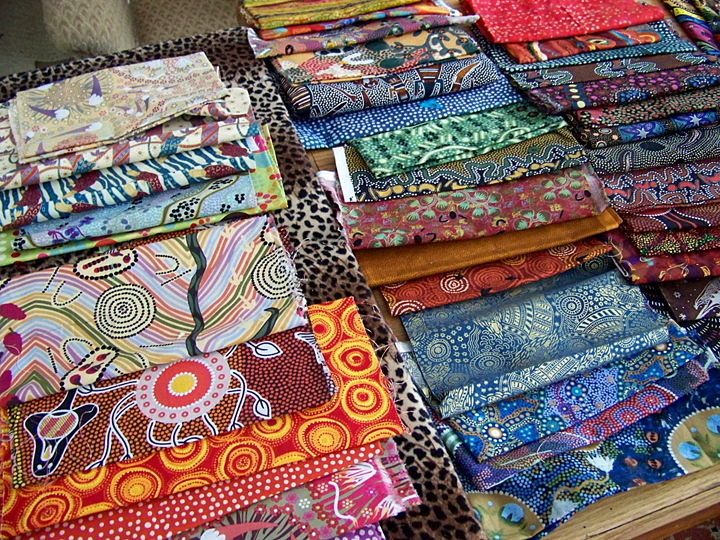
Despite her obvious beauty (!) making a quilt of Pippin wasn’t a priority. Pippin was deep into middle-age when I decided to enter a quilt in the 2011 Houston International Quilt Festival. The theme for that year’s special exhibit was “Good for You.” Like many competitions, they required that the quilt be a new work. It didn’t take long to come up with a justification for how a portrait of Pippin would fit in the “Good for You” theme. Here’s the description that accompanied my entry:
Pets, like our dog Pippin, enrich our lives. The fact that she is not of a breed recognized by the American Kennel Club does not dismay Pippin any more than it does us. She is plainly satisfied to be partly or wholly (who knows for sure?) dixie dingo, the wild dog of the Americas. She reminds us to be happy with who and where we are. Sitting in the sun is an opportunity to practice her philosophy of living in the moment. While correct posture is an important habit to cultivate, it is sometimes preferable, indeed sometimes necessary, to slouch. Simplicity is her touchstone: warmth, food, and affection are all that are really needed. Though on her short list of indulgent behaviors are: begging for dog biscuits, snitching compost scraps, fighting strange dogs, and rolling in anything rotten (either animal or vegetable, it matters not, nor is it always clear). The only thing better than lying in the sun is: sleeping in the sun, of course. Even sitting up her eyes droop and she snoozes, though it is better obviously to stretch out, turning from belly to side to back in order to ensure even distribution of the sun’s rays. Sometimes, when she is lying belly up with legs in the air, her tail will wag, though we have not moved or spoken. Is there any clearer indication that she is happy? Is there any clearer invitation to be happy ourselves?
Making “Dixie Dingo Dreaming”
Pippin had two poses that were typical of her. One was lying with her paws crossed in front of her. This dainty pose belied her ferocious demeanor whenever strangers came to the door, which was less Lady and more Cujo (think bared teeth and flecks of foam). The other pose we later learned is called the cattle-dog slouch. She would sit this way when very relaxed, rear legs splayed out, in a not-very-ladylike way.
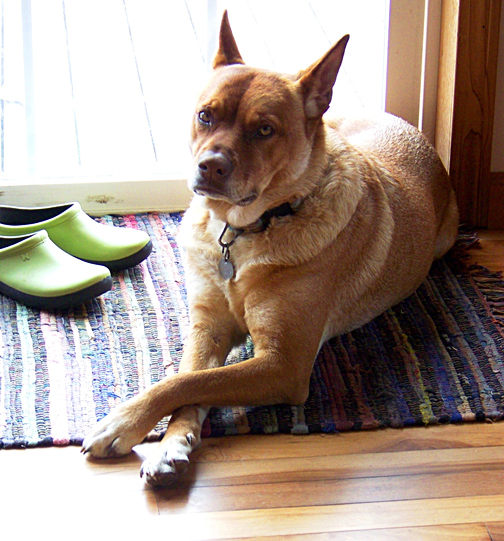
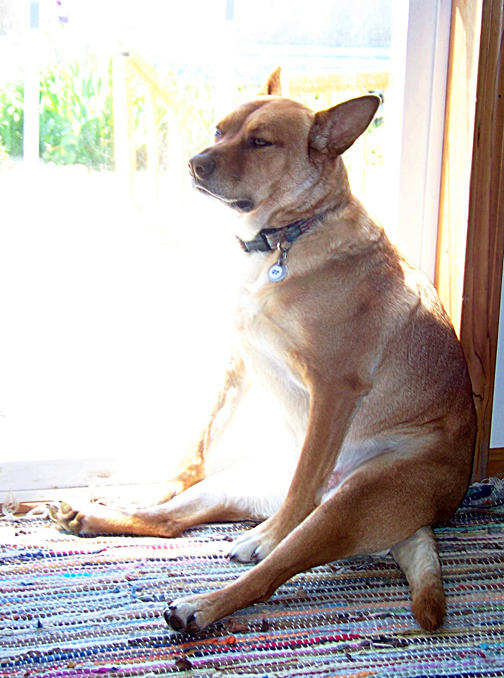
After reviewing my photos I chose the second pose. It was more dynamic (despite the sleepiness evident in her body) and more uniquely her. So as I explained in a previous post, it was time to make a pattern and transfer it to a backing fabric. I wanted her to be life size, so I measured her sitting up and figured out how much to enlarge my outline drawing. The full-size pattern is tiled together from about twelve separate pieces of paper.
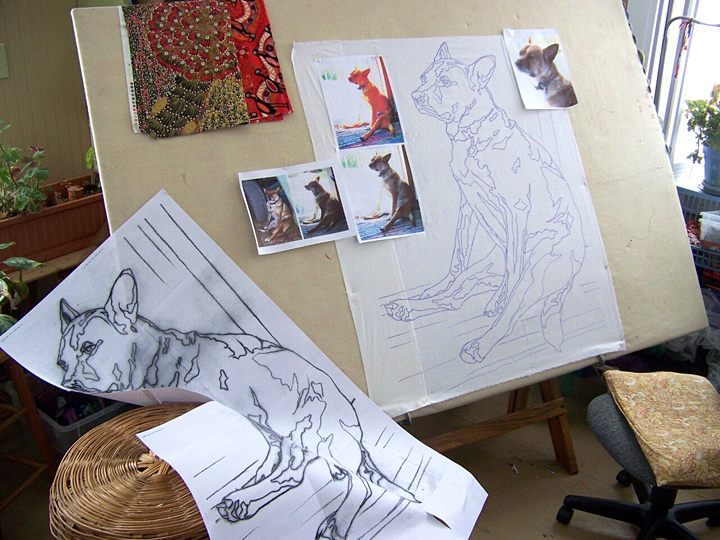
As is my habit, I started with her face. That’s the most interesting part for me, and provides an anchor for me to work out from. If I’m happy with the face, the rest seems easier somehow.
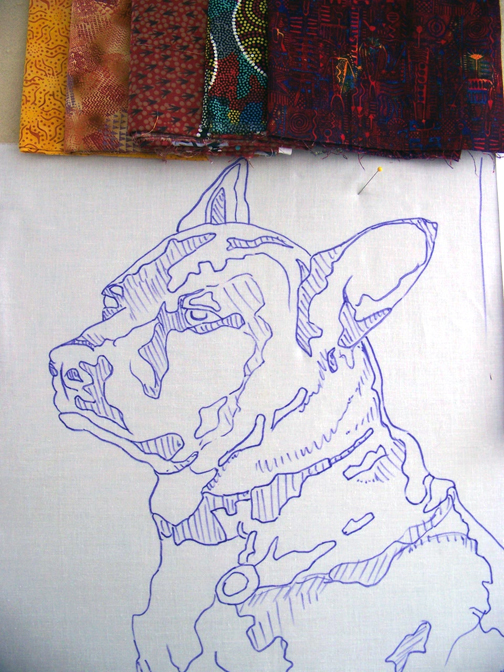
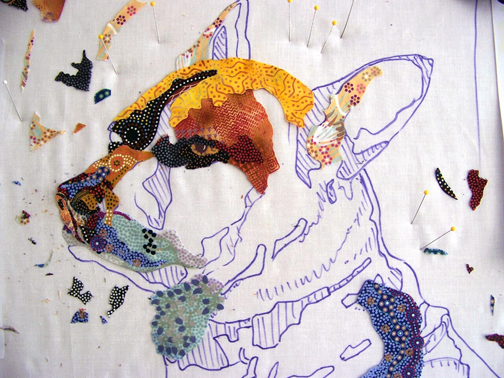
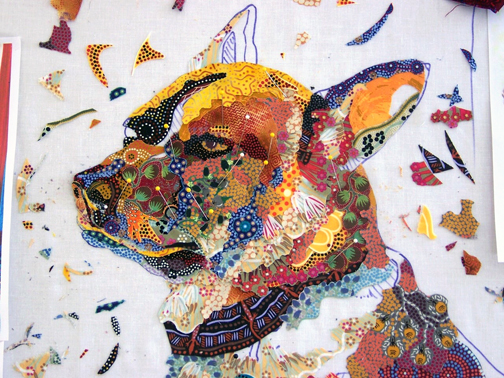
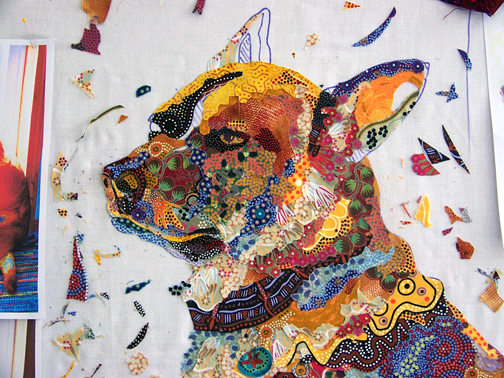
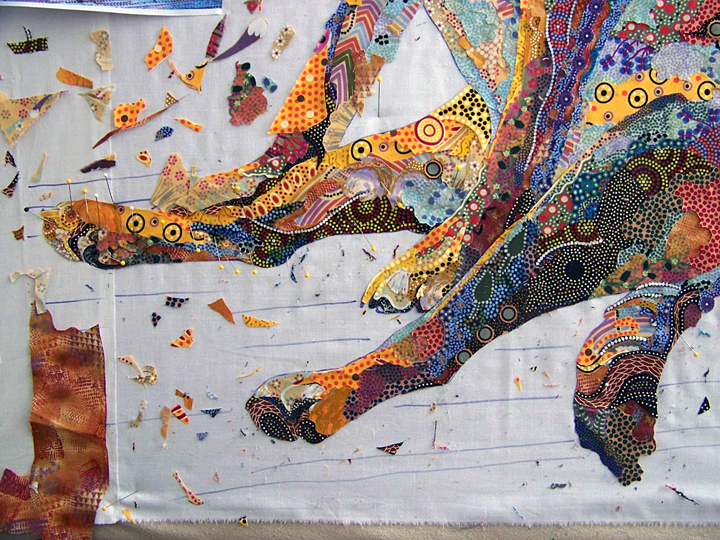
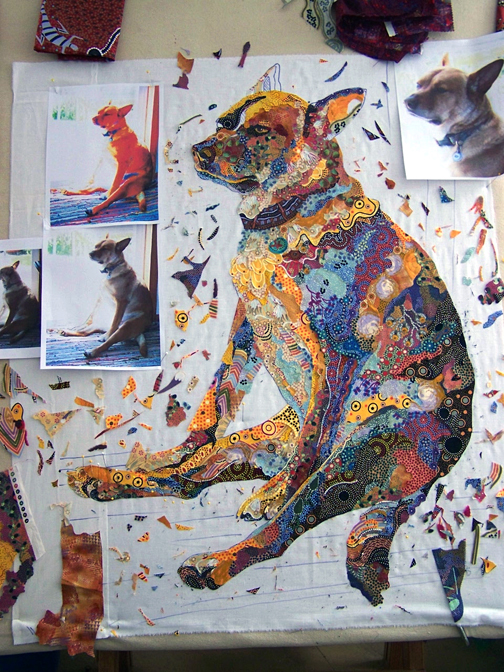
Once I had Pippin almost done. I started to think about backgrounds. At this point, it occurred to me to check the requirements for entry into the “Good for You” competition. Good thing I did. The minimum size for inclusion was 4 x 4 feet. It was lucky I had made Pippin as large as I did, but because she is mostly vertical in format, it meant I would have some width to make up.
Since the photo was of her sitting in the sun, it made sense to include a sun in the composition. In my research, however, I discovered Australian Aborigines didn’t seem to have a symbol for the sun. That would have been the obvious solution. Instead, and luckily, I was forced to create my own sun.

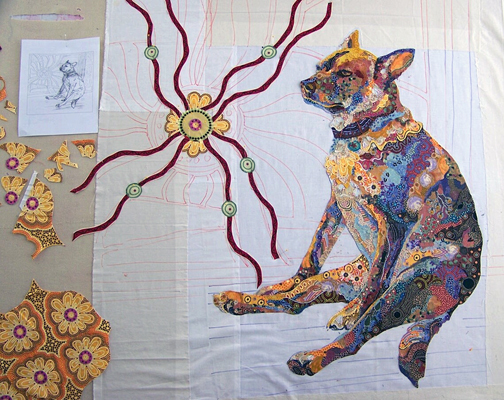
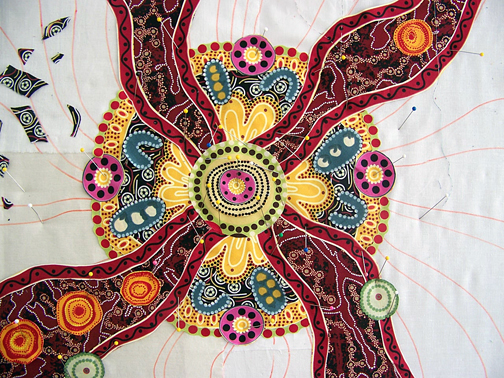
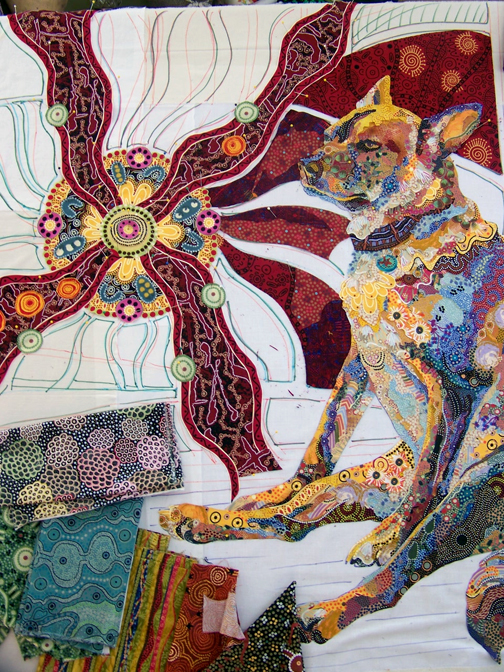
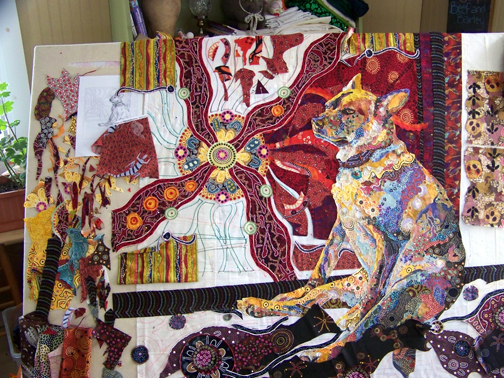
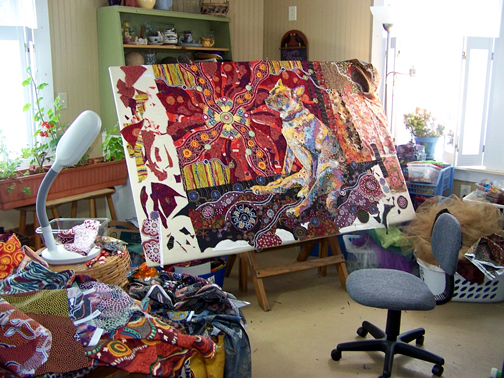
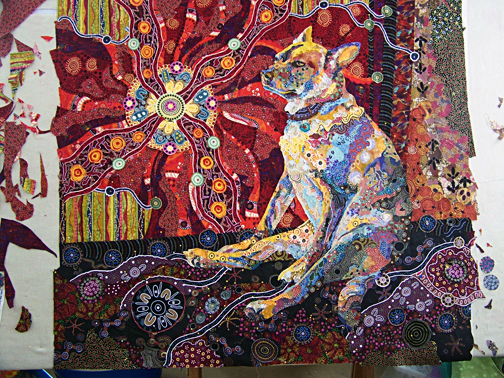
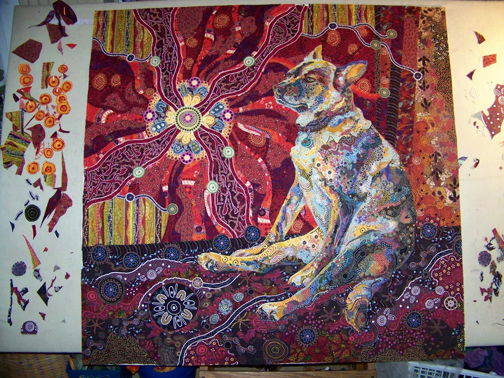
Houston
Not only was “Dixie Dingo Dreaming” accepted into the Houston exhibit, but it won first place in the “Good for You” exhibit. I traveled to Houston to accept the award, accompanied by my mother, Meta. In my short internet biography I say that I am a “long-time student of the Meta Carlson Studio of Fabric Creations,” e.g., my mom’s sewing room. Her strong influence on my life made it especially meaningful to have her there with me.

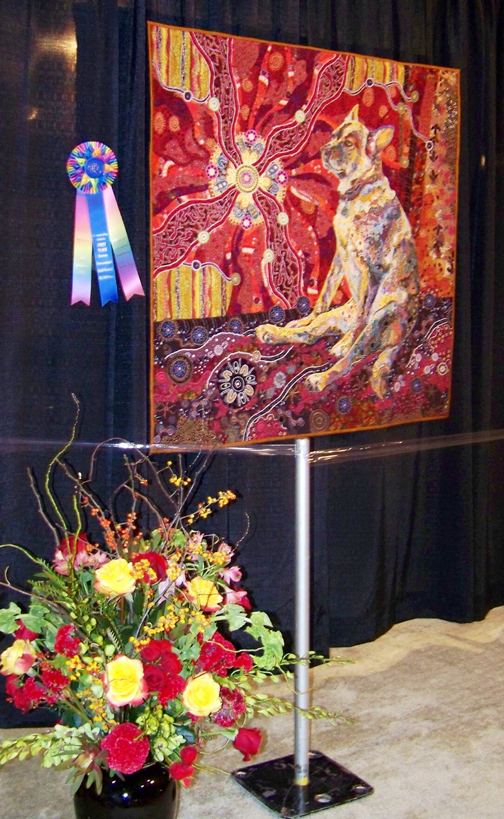
Symbolism
One of the few things I knew about Aboriginal art was that their images have layers of meaning. Unless you’re a part of that culture, you might not be privy to the deeper meaning of these abstracted shapes. However, the more superficial explanations are shared and I used these to create my own story of our own family in the background of the quilt.
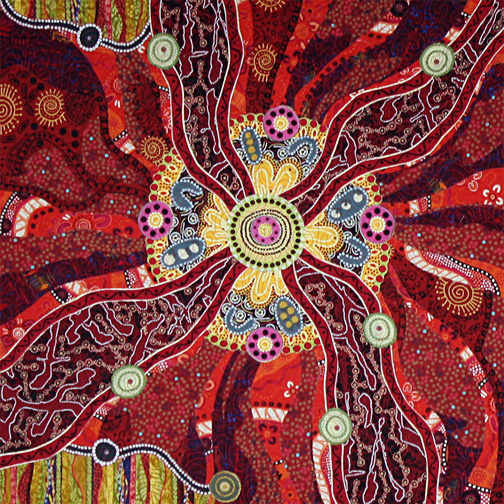
In the center of the sun, concentric circles of dots represent a campfire in a village, similar to the fire pit in our lawn. Around the campfire are four blue-gray, U-shaped symbols. Those represent tribesmen, or the four of us: me, my husband, our son and the dog. Next to us are ovals with dots in them: baskets of food. There we are, around the campfire sharing a meal.
Wavy lines coming off from the inner circle represent journeys. So there are four main rays, one for each of us, that represent each of our journeys in life. When a smaller circle intersects one of the rays, that represents a pause in the journey. Someone pointed out to me that one of those journeys has two stops on it. “Well that must be your dog’s journey,” she said. Why? “She was someplace else before she came to you. So that’s hers. You became the second pause in her journey.”
The black and white horizontal wavy lines throughout the piece represent the journey of our cat Max, because he was an independent soul who wandered in and out of our lives, mostly coming in only for food and warmth, then wanting to be let back out.
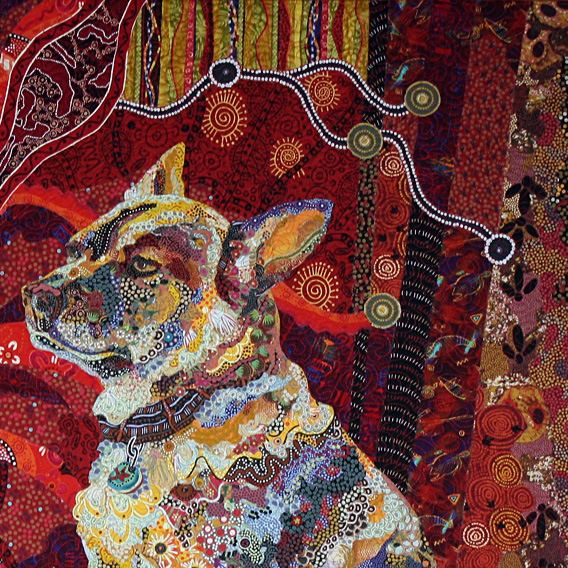
On the far right you see bird prints, which are supposed to be emu prints, but in our case represent our budgie Kiiora’s prints, which finishes the members of our family at that time. Not only are there footprints, but also eggs because she has laid dozens of (unfertilized) eggs in her lifetime.
So you see, “Dixie Dingo Dreaming” is a portrait of our dog, but it is also the story of our family at that time.
Serious Art
Does the sentiment on display (and hidden in its private symbols) in “Dixie Dingo Dreaming” prevent it from being “serious art”? I don’t know, but I do know that removing the sentiment from this piece, if you could do such a thing, would diminish it. I made it with love and when I look at it I remember the love Pippin gave me. I think that is clear to just about everybody who sees the piece.
Personally, I prefer art with heart. It takes guts for any artist, whether professional or novice, to lay out his or her feelings for others to examine, pore over, and critique. It takes courage to express sentiment, while it’s possible to hide behind being flip, detached, and ironic.
There was no irony in Pippin. She gave life her all. She devoured every biscuit she was offered. She tried to dominate every dog she met. She enjoyed every sunbeam and belly rub.
I call that serious art.
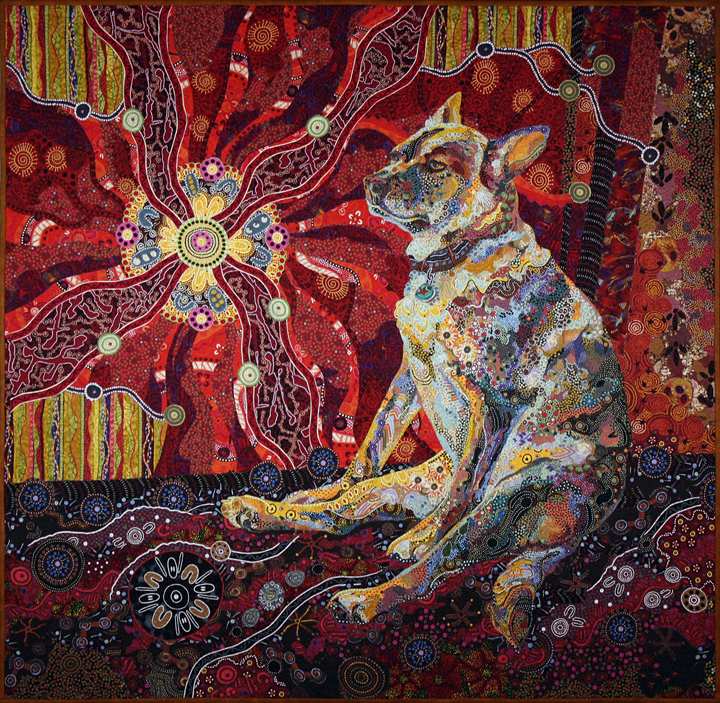
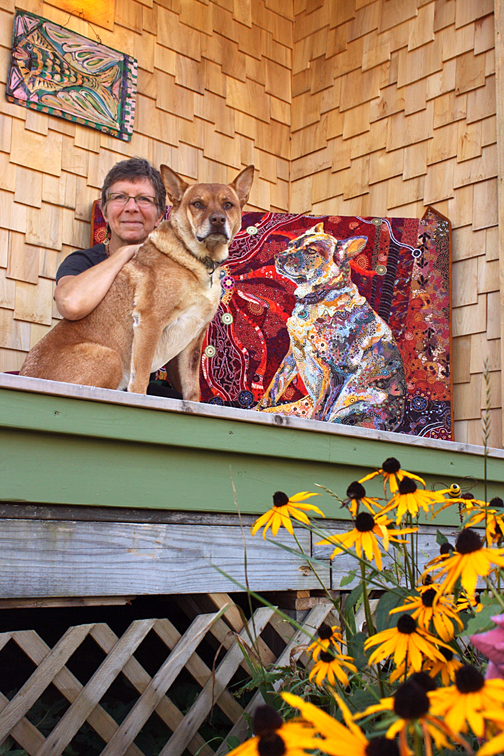
Beautiful quilt and story
Your post educates about a number of subjects. By the end, I have passed through fascination and astonishment and arrived at the state of respect.
Your art lifts and enlarges my soul – every time I see. What could be more serious or emotive than that? Dingo is a true beauty.
Wonderful! Our stories are in our quilts and I love yours. Thank you.
I think of serious artists not by the topic, but by how serious the artist is about creating. And you are definitely serious in my mind. Your methods and thought that goes into your art, your teaching ability, it all shows how serious you are about your art.
I enjoyed the story line about the background of this “serious art”, as it really does give it so much more meaning. Thanks for sharing your art and love of fabric, as always, you are a great inspiration to my dormant and sometimes sleepy creativity.
When I see that I’ve received a post from you I stop whatever I’m doing, because I know I’m going to enjoy every word of it. Thank you for sharing yourself with us.
Amazing – what a labour of love on the Dixie Dingo piece. You are such an inspiration to the community of quilt artistry. Thank you for sharing your process. It is nice to see the scale of the work, too and the details. I have a question about the board you are working on. Can you describe how it works?
Carolyn D. Hall
Best wishes, Carri (Carolyn) Hall, MA (Communications and Technology)
Freelance writer and editor Specialist in writing for the Web
Fine Balance writing blog: http://carrid.wordpress.com Going to See travel blog: http://goingtosee.wordpress.com
E-mail: carri.hall@gmail.com Winner of the 2011 Alberta Literary Award, Jon Whyte Memorial Essay
On Sat, Apr 9, 2016 at 2:02 AM, Susan Carlson Quilts wrote:
> Susan posted: “Sometimes I wonder if I’m a “serious” artist. I mean, I > don’t really worry about it, but it crosses my mind. Anyway, do I really > want or need to be a “serious” artist? And what is “serious” art anyway? I > suppose it’s art with a purpose, with an important” >
You have not only a wonderful manner of composing your pieces, you also have a wonderful way with words. I often am at a stand still when considering some of the abstract and often very serious themes offered in competitions and eventually decide not to partake. Those I have done for those themes become a bit stilted. But those I make from the heart, as you say, flow so smoothly and are much more fun to create. As Bev says above, I too stop everything to read your posts. Thanks!
Type of board: It’s a drafting board, to which I have attached a piece homosote, a cardboard-like sheet of building material. It allows me to pin into it. See my post on my studio: https://susancarlsonquilts.wordpress.com/2016/01/31/its-in-the-details-my-studio/. It has other pictures of the board.
Your story, not just of Dixie Dingo, but the family imagery, and process of making such a spectacular piece, is simply wonderful. I have 2 rescue dogs who are often privy to my most intelligent musings and never judge when I talk to myself in the studio.
I love your work, without any labels of ‘serious’ or ‘not-serious’…those are just boxes somebody wants to put us in as artists. Really, the Mona Lisa is just a portrait, and Monet’s garden was just a bunch of flowers – but does anyone think those works aren’t “serious art”?
How precious that your mother was able to be present when you won an award in Houston!
There’s a quote in my studio that I look at every day, and your post reminds me of these words…”CREATING art is a process of DISCOVERY and not KNOWING ahead of time exactly what you are doing or exactly how it will turn out.” Nancy Crow
Cheers to a beautiful quilt and an equally beautiful story,
Beth Markel
Such a beautiful “work of Art”. I love the colors, the Reds esp.
Stunning work! I am a mosaic artist (and quilter wannabee) so I totally related to your process and what you wrote about being a serious artist. Your sense of design and composition, use of value, pattern and color are exquisite. You are a very serious artist as far as I’m concerned and an excellent one.
I have always thought of you as a joyful artist that adds a bit of your humor and a lot of your soul to your work. Your work has always made me smile. Your art is as vibrant, just as you are as a person a teacher.
A truly inspiring work of art. Thank you.
Thank you for sharing your art and your story with us. You are an inspiration.
HI Susan,
thanks for telling the story that goes along with your quilt. About the “serious ” artist statement. I don’t feel as if
I am a “serious”artist either but I do love what I do and create. Thanks for the chat.
Thank you Susan, for a wonderful post. I believe a piece of good art has to have meaning to the artist. Viewers will bring their own meanings to the piece, but the art won’t “speak” unless there is something in its creation.
Thanks, Sunnie.
Somehow I have not seen this quilt before, so I am very glad The Quilt Show shared the link! I love how the requirement of the contest forced you to make the quilt bigger, create all this wonderful back story and context, and resulted in something much deeper. I will see Australian aboriginal fabrics in a different light now — I had a hard time understanding their potential before. Dreamtime dog! Much more interesting than batiks.
To me, the things that connect with people on an emotional level are the things most worth doing, whether you call them art, craft, or surfing! But I am glad you felt motivated to share your process, because that is very inspirational indeed. 😀
The love of your dog and your art both show through. Isn’t the successful art always done with passion and personal meaning? How could a piece that is created without that part of the artist be anything of meaning? Even commercial artist put part of themselves into their work in order to be successful.
Thank you so much for sharing your work. One question that begs answering: How long did it take start to finish to complete this quilt. I suspect it will be longer than anyone can guess.
I hate to sound evasive, but I don;t keep close track. And when would I “start the clock” anyway? When I get the idea? When I start collecting fabrics for the piece? Only when I have sat down and placed the first piece of fabric? How about a vague answer: a few months. It takes long enough for me to make a quilt, that I typically make only one quilt a year, but that’s because of my teaching commitments.
This post is overflowing with artistic flair. The quilt is beautiful! This post tickles the quilt genes deep within. The writings about the dog, truly admirable. To many more wins in Houston!…. you definitely got game!